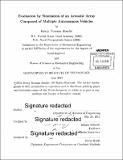| dc.contributor.advisor | Henrik Schmidt. | en_US |
| dc.contributor.author | Bosché, Kerry Noonan | en_US |
| dc.contributor.other | Massachusetts Institute of Technology. Department of Mechanical Engineering. | en_US |
| dc.date.accessioned | 2015-12-03T20:53:37Z | |
| dc.date.available | 2015-12-03T20:53:37Z | |
| dc.date.copyright | 2015 | en_US |
| dc.date.issued | 2015 | en_US |
| dc.identifier.uri | http://hdl.handle.net/1721.1/100103 | |
| dc.description | Thesis: Nav. E., Massachusetts Institute of Technology, Department of Mechanical Engineering, 2015. | en_US |
| dc.description | Thesis: S.M., Massachusetts Institute of Technology, Department of Mechanical Engineering, 2015. | en_US |
| dc.description | Cataloged from PDF version of thesis. | en_US |
| dc.description | Includes bibliographical references (pages 61-62). | en_US |
| dc.description.abstract | Ship-towed arrays have been integral to Navy combatant operations for many decades. The continual advancement of towed array technology has been continually driven by the need for high sensitivity, low self-noise, and response across a wide range of frequencies. Robotic autonomy, as applied to acoustic sensors, is currently operationally limited to deployment of traditional arrays from semi-submersible tow vehicles. while such a configuration facilitates flexibility in array placement and a measure of stealth, it is an intermediate step toward fully-submerged, autonomous arrays. In contrast to a traditional hard-wired acoustic array, a "virtual" array, in this thesis, consists of multiple, untethered, hydrophone-equipped autonomous underwater vehicles (AUVs) maintaining alignment by unspecified means. Due to the flexibility of its physical configuration, a virtual array can be both steered in angle and tuned via element spacing - to optimize response. This research explores the performance of a simple acoustic underwater virtual array (AUVA). Basic software for controlling an AUVA is implemented and evaluated using computer simulation of array navigation. Simulation of a narrowband, beamforming sonar is used to assess AUVA performance under the control scheme. This research provides a basis for expanding the use of autonomous vehicles for acoustic sensing. | en_US |
| dc.description.statementofresponsibility | by Kerry Noonan Bosché. | en_US |
| dc.format.extent | 62 pages | en_US |
| dc.language.iso | eng | en_US |
| dc.publisher | Massachusetts Institute of Technology | en_US |
| dc.rights | M.I.T. theses are protected by copyright. They may be viewed from this source for any purpose, but reproduction or distribution in any format is prohibited without written permission. See provided URL for inquiries about permission. | en_US |
| dc.rights.uri | http://dspace.mit.edu/handle/1721.1/7582 | en_US |
| dc.subject | Mechanical Engineering. | en_US |
| dc.title | Evaluation by simulation of an acoustic array composed of multiple autonomous vehicles | en_US |
| dc.type | Thesis | en_US |
| dc.description.degree | Nav. E. | en_US |
| dc.description.degree | S.M. | en_US |
| dc.contributor.department | Massachusetts Institute of Technology. Department of Mechanical Engineering | |
| dc.identifier.oclc | 929459111 | en_US |
